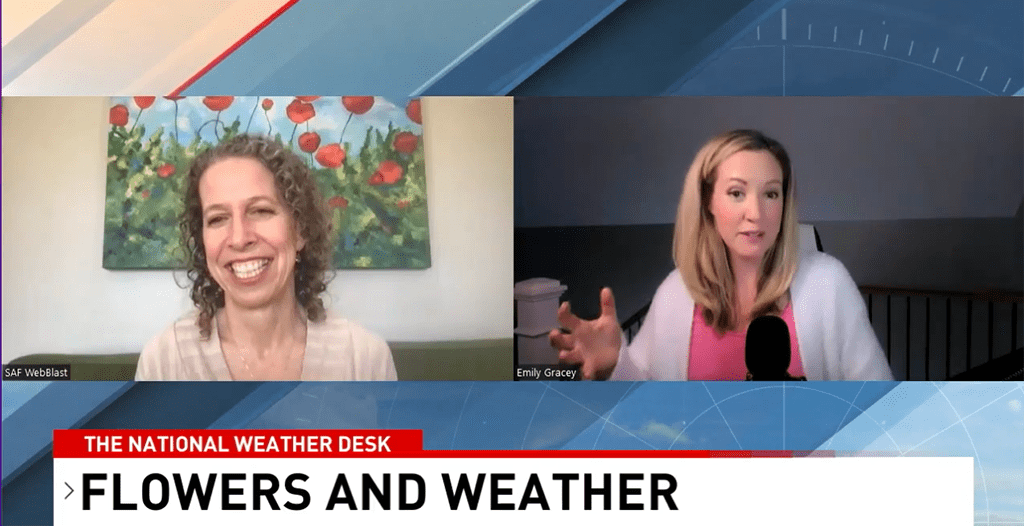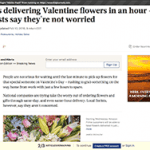
SAF CEO Kate Penn talked with a reporter for The National Weather Desk about the impact of weather on Valentine’s Day.
The media loves to find new angles for its annual coverage of Valentine’s Day, and this year many news outlets honed in on the rising cost of flowers and sustainability issues.
The Society of American Florists — and its members who made the news — deftly handled those media inquiries, using them as an opportunity to promote flowers as an affordable gift and provide context to encourage more balanced news stories.
“As the industry’s advocate in the media, SAF always strives to promote flowers and thwart negative media coverage,” says SAF CEO Kate Penn. “Our efforts paid off this year with positive coverage that emphasized the wide range options for shoppers, regardless of budget, and educated consumers on where and how flowers are grown and how that impacts pricing.”
Influencing Coverage
In the weeks leading up to Valentine’s Day, SAF responded to about a dozen media requests seeking information about flower sales, rising costs, the impact of weather on crops, and sustainability.
The outcome was news coverage in which SAF and its members predicted strong sales, assured consumers that there was plenty of product available, explained the reasons behind the costs, and promoted different types of flowers as less expensive Valentine’s Day options in light of inflation.
In a segment for The National Weather Desk, Penn assured a reporter that flower buyers don’t have to worry about their Valentine’s Day flowers freezing in the winter weather. “The florist is not going to leave flowers on the front porch,” Penn said.
An article on Southforker.com, which spotlighted florists in the Hamptons, quoted Elizabeth Daly, marketing and communications manager for SAF, who explained why prices for flowers may be different from florist to florist.
“There are so many variables that go into pricing flowers — where and how they were grown; how much volume a retailer is purchasing, what the retailer’s overhead and labor costs are; where the florist is located in the United States,” Daly, told the publication, also emphasizing that on Valentine’s Day “the demand for roses is exponentially higher than any other day of the year.”
New York Times Takes Aim
Not all news coverage was favorable. A New York Times opinion piece, “I Love You, Too, But Let’s Skip the Roses,” published Feb. 13 not only discouraged readers from seeking out a local florist (“it’s very likely that all the florists in town are already booked. You’ll have better luck at your local grocery or big-box store,” it said), but it also made allegations about chemical use on farms and the carbon cost of transporting flowers from South America.
“The massive cut-flower industry — valued at $34 billion in 2019 — isn’t the most environmentally criminal of all commercial enterprises, but it’s far from benign,” opinion writer Margaret Renkl said in the piece.
Penn responded to the New York Times on behalf of the industry.
“Flower growers — both domestically and in other countries — make environmental and social responsibility a priority,” Penn wrote. Her letter cited the use of biological control agents used by many farms, as well as energy and water conservation efforts.
“As an industry, we have to get better at sharing the proactive sustainability efforts that are happening from breeders and growers to flower shops — otherwise, the uninformed will tell our stories for us, as happened with ,” says Penn, adding that encouraging, identifying and sharing the industry’s sustainability initiatives is a strategic priority for SAF.
SAF last year published the Sustainability Spotlight, a special edition of Floral Management magazine, in which floriculture companies and suppliers showcased their sustainability practices, which range from using biological fungicides to offsetting carbon emissions and a company that reused materials to expand its operations.
A second Sustainability Spotlight is slated for publication later this year.
Amanda Jedlinsky is the managing editor of SAF NOW.



